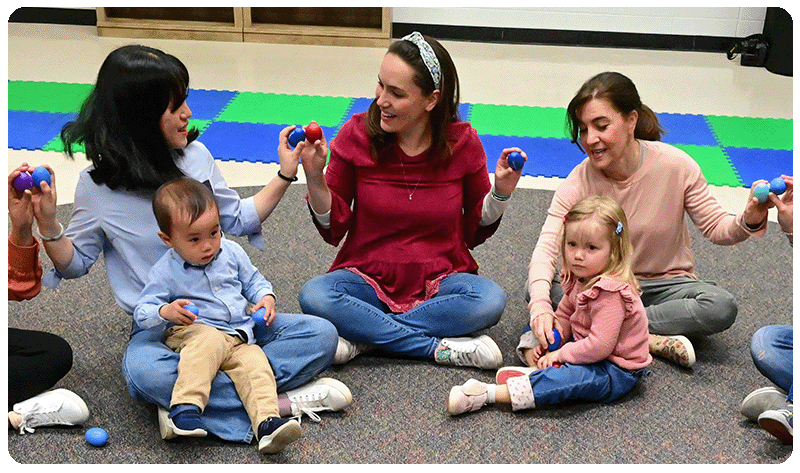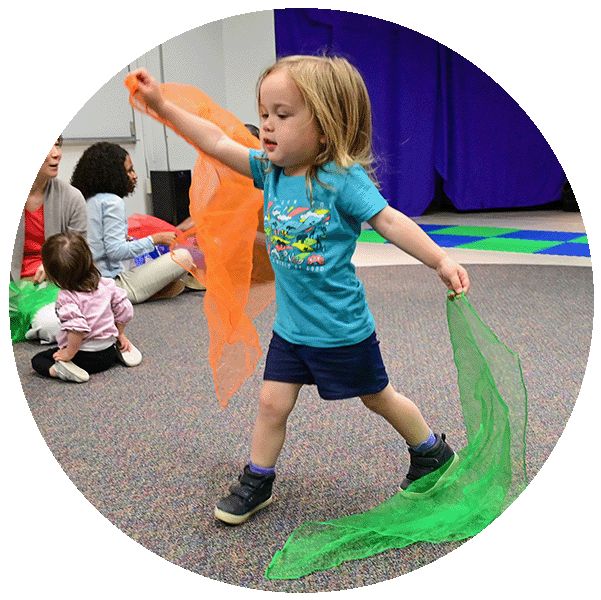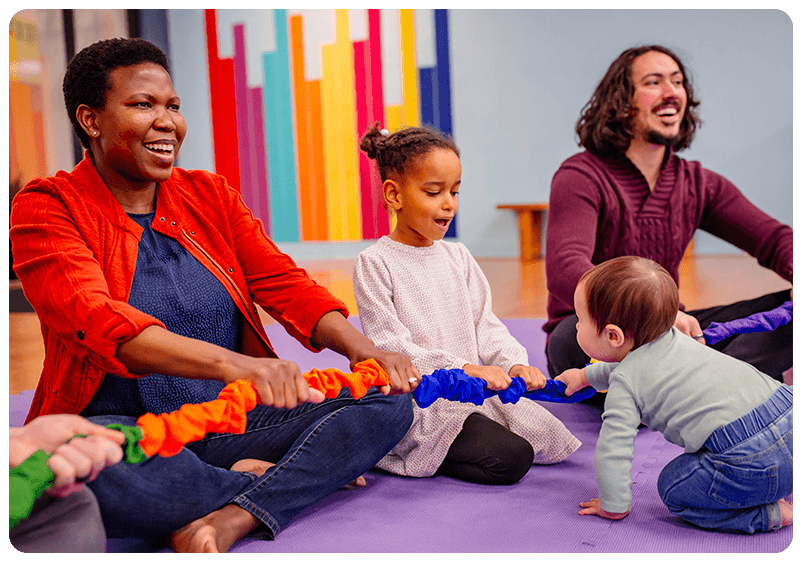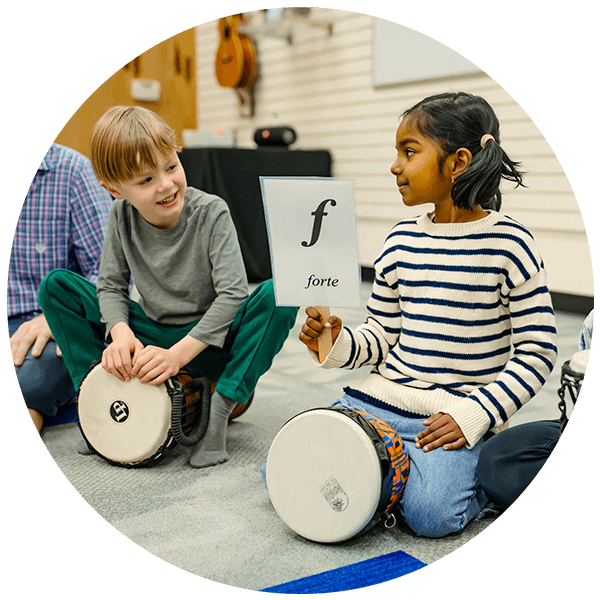Your Questions, Answered by Our Experts
Over the years, we’ve received many questions from Music Together parents like you. From wanting to know more about their child’s music development to what their child’s in-class behavior suggests, we’ve got answers! We’ve rounded up a few of the most common FAQs here.
For more from our experts, check out the Music Together Blog. Have a question of your own? Email it to news@musictogether.com or DM us @musictogetherworldwide on Instagram.
Answer: Much of the time, a child who appears to be “just watching” (like Sam) is actively absorbing the music and learning in their own way. This same kiddo often ends up surprising their grownups later, by actively playing with the music at home. This can look like a toddler who wanders around during class humming a tune in the car ride home, or a three-year-old who watches carefully for 45 minutes excitedly leading a music class for their stuffed animals a few days later!
So, why does this happen? Often, it’s partly due to the newness of the class experience: all the children, the grownups, the instruments, the music—it’s no wonder some children choose to simply watch and absorb. Then, when they go home to their own environment, where they feel safe and secure, the music comes out. They learn it in class, then practice it at home.

It’s also good to remember that children learn differently from grownups. What might look like disinterest in adults is often a natural part of a child’s learning process. Our little ones learn instinctively and constantly, absorbing the world through all their senses. They learn through immersion, interaction, and by imitating and playing with what they observe in their own way, in their own time. And, some children may lean into different learning styles. More visual or auditory learners keenly observe what they see or hear, while kinesthetic learners absorb it all through movement.
Sam watching what’s going on in class is all about how they learn. You can support their music development by participating in class yourself and observing how your child plays with the music at home and encouraging their explorations. And, don’t be surprised when they spontaneously start singing or leading YOU in a musical game!

Answer: While your child may appear to be more active than others in class, it is likely that they are connecting to the music in a kinesthetic way, tuning into the rhythm of songs and then responding with their own body movements. In a gym class, your little one would certainly get a chance to move, but it would be without the benefit of music—and that may be precisely what they’re responding to.
As you participate in class, notice how movement serves as a means to explore rhythm: strong accents in the music are expressed with correspondingly strong movements; changes in movement occur in relation to changes in the melody; short (staccato) or smooth (legato) movements accompany staccato or legato singing or instrument play; and the changing speed of your teacher’s movements corresponds to changes in the tempo of the music.
It’s possible your three-year-old’s movements are subtly attuned to what is happening in class, even if they appear unengaged. For example, Music Together teachers often notice that kinesthetic learners move around the room right on the beat, or that the tempo of their movement changes with the tempo of the song. That seemingly restless movement may, in fact, be the way that such learners focus.
The movement-oriented child will also be stimulated by the spaciousness of the classroom and will naturally want to move through it. Generally, we don’t require children to stay in their “spots” in a Music Together class, but it can really help if their grownups do. By staying in the circle and continuing to participate, you provide your mover with a home base to check back in on from time to time. Seeing that you prefer singing with the teacher may pique their interest and draw them back into the group—at least until some other lively song sends them dancing off again!
Answer: Music Together was the first early childhood music program to offer classes for mixed ages. (In the decades since, many others have followed our lead.) The relaxed, family-style environment lets all kids learn at their own pace.
As a two-year-old in a mixed-age Music Together class, your child might love to demonstrate what they can do for the babies in the room. At the same time, they’ll likely learn by watching the threes and fours (as well as the grownups!).

Early childhood education experts have long recognized the mixed-age classroom as the best way for young children to learn. Further recent research on mixed-age groups highlights additional benefits: support of empathy development, meeting children’s unique learning needs, the chance to learn by teaching, leading, and modeling, and a more creative and less competitive environment.
Luckily, Music Together families experience some of the benefits of mixed-age classes: fostering leadership, caring, empathy, and creativity—all of which support early music-learning and foster lifelong success in school and life. And, since much of the interaction in our classes is between caregiver and child, the mixed-age model encourages everyone to adapt the activities to suit the age and stage of their own child, without pressure for participation to look just like everyone else in the room!
Answer: Great question! Check out “The Next Step,” a blog post by Music Together Worldwide Founder/Artistic Director Ken Guilmartin, for recommendations and questions to consider when making the decision about when to start formal music instruction.

Most children—even the obviously musically inclined—can benefit from waiting a little longer to start traditional lessons than you might think. To have a good chance of enjoying and embracing formal music study, a child must have a readiness that goes beyond the traditional prescription of being able to sit still for fifteen minutes, count from 1 to 5, and know the letters A to G. It’s important to consider your child’s temperament, physical development, and level of tonal and rhythmic competence before signing them up for lessons, and to ask yourself what you as a parent want for your child.
Some general recommendations:
Children develop at different rates physically, emotionally, socially, and musically, so the following can be only approximate guidelines for what might be best at different ages.
- Threes and fours will continue to thrive in group music classes that allow for a direct, playful experience of music and movement. Create a music environment at home, too, by integrating spontaneous music-play into your daily life.
- Fives and sixes will continue to thrive in group classes like Rhythm Kids®, where they can begin to apply basic music skills to a variety of music and movement experiences, including drumming, improvisation, singing, choreographed dance, musical games, and age-appropriate interactions with music notation.
- Seven to nine is often a good time to explore traditional lessons. Choose a teacher you think is a good temperamental match for your child. It’s more important at this point for them to fall in love with their instrument than work with a noted maestro. (That can come later!)
- Ten and older is not too late to begin! The older child tends to be focused and to progress rapidly. Sometimes, however, they may find beginner music to be “babyish,” so the choice of materials will be crucial. Try Béla Bartók’s Mikrokosmos, a series of books with musically interesting exercises that older children find appealing.



